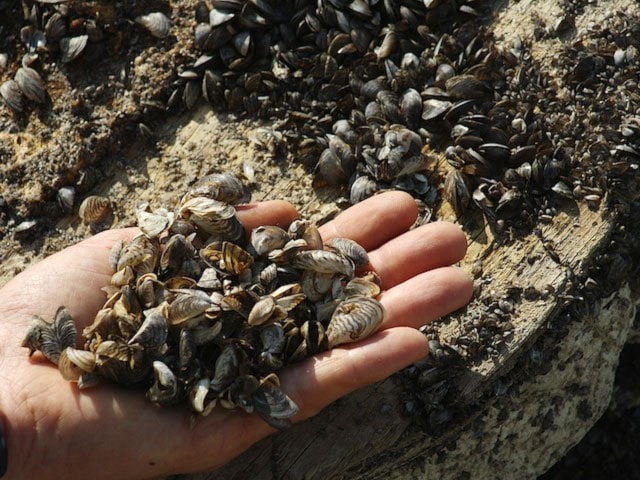Montana is currently grappling with a feared potential environmental catastrophe for the Okanagan Valley — an invasion of zebra and quagga mussels.
The state, along with B.C., Alberta, Saskatchewan, Washington and Idaho, created the Pacific Northwest Perimeter Defence to prevent the mussels from infesting local waterways.
But that defence perimeter was breached in November, when mussel larvae were detected in the Tiber and Canyon Ferry man-made water reservoirs in north-central Montana.
This week, further preliminary testing suggested that the invasive mussels have not yet moved into other Montana water bodies, while the adult source of the larvae remain undetected.
Of the 372 water samples tested, none revealed new mussel detections, said Jeni Flatow, spokesperson for the mussel incidence response team struck by the Montana state governor last month.
Flatow said the sampling will continue but the focus right now is on the two reservoirs where the positive larvae detections were uncovered.
"We haven't been able to find the adult mussels yet but the assumption is if we find larvae, then there have to be adults somewhere," she said.
 Dogs were brought in from Alberta last month, specially trained to smell out mussels potentially hiding in the reservoir shoreline rocks and crevices.
Dogs were brought in from Alberta last month, specially trained to smell out mussels potentially hiding in the reservoir shoreline rocks and crevices.
"The dogs had some positive hits but nothing came of it in terms of any adult mussel discovery," Flatow said. "We sent in divers and snorkelers in those areas as well to try and get a visual detection as a followup but nothing was found."
She acknowledged that the hunt for the adult mussels is looking for the proverbial needle in a haystack.
"These reservoirs are hundreds of acres in size so trying to narrow down the location of where adult mussels might be is very difficult. But we keep sampling and looking, to try and figure out where they might be," she said.
Last week, the Okanagan Basin Water Board repeated the plea it's made in previous months for the federal and provincial governments to step up monitoring campaigns for the invasive mussels in light of the larvae discovery in Montana.
"We have been calling on the federal government, and the province, for a stronger defence system since 2012. And it has improved," said OBWB board chair Doug Findlater last week.
"We are pleased to see this, but there are still gaps in our defence with inconsistent enforcement at our borders, and inspection hours that are not long enough. This, and more, needs to be fixed now, before next year's boating season."
The source of concern for Findlater, also the mayor of West Kelowna, is a 2013 study by the OBWB that a zebra or quagga mussel infestation could mean an economic hit to the Okanagan of $43 million each year in lost tourist-related revenue, along with the costs of maintenance for water infrastructure in Okanagan Lake that would suffer irreparable ecological damage.
Flatow said those potential economic losses and its role within the perimeter defence system means the mussel breach is something her state takes very seriously.
"We recognize the impact and concern this causes for our neighbours in Canada and the U.S. and why we very much pay attention to it and are concerned by it," Flatow said.
Besides ongoing water sampling and the creation of a mussel incident response team, plans are in the works to implement a strategic plan of inspection and public awareness next spring and summer, Flatow said.
The state also recently hosted a conference with experts in the field of invasive mussel detection and containment to seek out ideas on how Montana should proceed.
Flatow said there is no surefire solution once an adult mussel invasion is positively detected.
"There are options to consider as a response but it depends on what we find and where the adult populations may be," Flatow said.
"The drawdown of the reservoirs and chemical control measures are two options often discussed but there are side-effects from an ecological perspective that also have to be weighed.
"For example, the chemical option could be detrimental to other species in the water so those consequences have to be considered."
And, whatever Montana wildlife and environment officials ultimately decide is necessary, funding will be an issue when the state legislature reconvenes in January.
As has been the case in B.C. from the OBWB's perspective, government funding for programs to help prevent the spread of the mussels, a big part of that being inspection stations where boats are examined before entering local waterways, has been shortchanged, according to a report in The Spokesman-Review newspaper in Boise, Idaho.
State and federal officials from the northwest states worked together to persuade the U.S. Congress to allocate $4 million for use in 2016 to help Idaho, Montana, Oregon and Washington expand those prevention efforts.
But the states have not received any of that money yet, due to what one Idaho politician called a "language hiccup."
The U.S. Army Corps of Engineers interpreted the purpose of the funds differently from the states awaiting the funding and it was directed elsewhere.
"Had the money been there to help double the work being done at the boat check points, the originator of these mussels might have been picked up before they were in the water," said Mike Cuffe, a Republican Montana state legislative representative.
